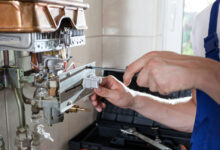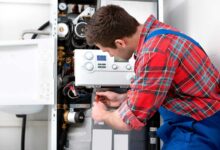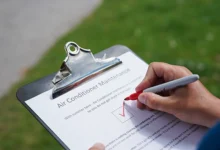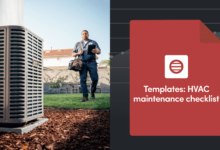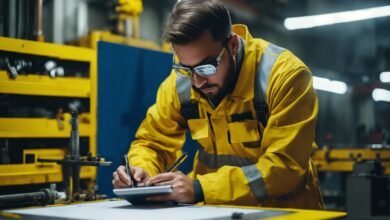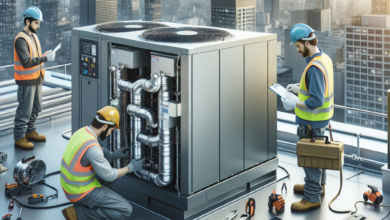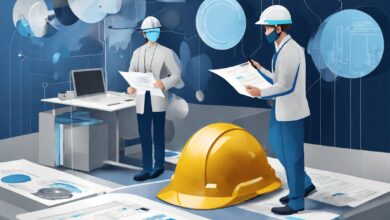What Does HVAC Maintenance Include?
What Does HVAC Maintenance Include? – Regular HVAC maintenance is crucial for the efficient functioning and longevity of your heating, ventilation, and air conditioning system. It not only helps you avoid costly repairs but also ensures that your HVAC system operates at peak performance, keeping your indoor environment comfortable throughout the year. In this comprehensive guide, we will delve into the various aspects of HVAC maintenance and highlight the key components that should be included in a professional maintenance service.
Inspection and Cleaning of Air Filters
One of the most important aspects of HVAC maintenance is the inspection and cleaning of air filters. Air filters play a vital role in trapping dust, pollen, pet dander, and other airborne particles, preventing them from circulating in your home. Over time, these filters can become clogged, restricting airflow and reducing the efficiency of your HVAC system. During maintenance, a technician will inspect the air filters and clean or replace them if necessary.
Why is it important?
Clean air filters ensure proper airflow, allowing your HVAC system to operate efficiently. When filters are clogged, the system has to work harder to push air through, resulting in increased energy consumption. Additionally, dirty filters can lead to poor indoor air quality, causing allergies, respiratory issues, and unpleasant odors in your home. Regularly inspecting and cleaning or replacing air filters as part of your HVAC maintenance routine is essential for optimal performance and healthier indoor air.
How to inspect and clean air filters?
To inspect and clean air filters, start by turning off your HVAC system. Locate the air filter compartment, which is usually near the return air duct or furnace. Open the compartment and carefully remove the filter. Examine it for any visible dirt or debris. If it appears dirty or clogged, it’s time to clean or replace it. If the filter is washable, follow the manufacturer’s instructions to clean it thoroughly. If it is not washable, replace it with a new filter of the same size and type. Remember to always turn off your HVAC system before removing or installing filters.
Cleaning and Maintenance of Condenser Coils
The condenser coils in your HVAC system are responsible for releasing heat from the refrigerant, allowing it to cool and circulate throughout your home. Over time, dirt, dust, and other debris can accumulate on these coils, hindering their ability to transfer heat effectively. As part of your HVAC maintenance, cleaning and maintaining the condenser coils is crucial to ensure optimal performance and prevent any potential issues.
Why is it important?
When condenser coils are dirty, they cannot dissipate heat efficiently, causing your HVAC system to work harder to cool your home. This increased workload can lead to higher energy consumption, reduced cooling capacity, and potential system breakdowns. By regularly cleaning the condenser coils, you can improve the overall performance of your HVAC system, enhance energy efficiency, and prolong its lifespan.
How to clean condenser coils?
Cleaning condenser coils requires a careful and thorough approach. Before starting, make sure to turn off the power to your HVAC system. Begin by removing any debris or loose dirt from the exterior of the unit using a soft brush or vacuum cleaner with a brush attachment. Once the surface dirt is removed, you can access the condenser coils. Use a coil cleaning solution recommended by the manufacturer and apply it to the coils, following the instructions provided. Allow the solution to sit for a few minutes to loosen any stubborn dirt or grime. Then, rinse the coils thoroughly with water using a hose or pressure washer. Take care not to damage the delicate fins of the coils. Once cleaned, allow the coils to dry completely before restoring power to your HVAC system.
Lubrication of Moving Parts
HVAC systems consist of various moving parts such as motors, fans, and bearings that require proper lubrication to reduce friction and prevent premature wear and tear. Regular lubrication as part of maintenance keeps these components running smoothly and decreases the chances of breakdowns.
Why is it important?
Proper lubrication of moving parts is essential to minimize friction, heat, and wear, ensuring the efficient and reliable operation of your HVAC system. When these parts are not adequately lubricated, they can become stiff, leading to increased energy consumption, motor overheating, and potential system failures. Regular lubrication during HVAC maintenance extends the lifespan of these components, reduces the likelihood of costly repairs, and promotes smooth operation.
Which parts require lubrication?
There are several components in your HVAC system that require lubrication, including the blower motor, bearings, and fan blades. Consult your HVAC system’s user manual or the manufacturer’s recommendations to determine the specific lubrication points and the type of lubricant to use. It is essential to choose the correct lubricant to avoid any damage or adverse effects on the components. If you are unsure or uncomfortable performing this task yourself, it is recommended to seek professional HVAC maintenance services.
Inspection and Cleaning of Drainage System
HVAC units have a drainage system that removes excess moisture from the air. However, this system can get clogged with dirt, mold, or algae, leading to water leakage or even system damage. Proper inspection and cleaning of the drainage system during maintenance help prevent such issues.
Why is it important?
A clogged drainage system can cause water to accumulate and pool inside your HVAC unit, leading to water damage, mold growth, and even electrical malfunctions. By regularly inspecting and cleaning the drainage system, you can ensure that water is properly draining away from the unit, reducing the risk of leaks and associated problems. Additionally, a clean drainage system helps maintain the desired humidity levels in your home, preventing excess moisture-related issues.
How to inspect and clean the drainage system?
Start by locating the condensate drain line, which is usually a PVC pipe connected to the indoor unit of your HVAC system. Inspect the drain line for any signs of blockage, such as standing water or a slow drip. If you notice any blockage, it’s time to clean the drain line. You can use a wet/dry vacuum or a specialized drain line cleaning tool to remove the clog. Insert the vacuum or tool into the drain line and apply suction or pressure to dislodge the blockage. Once the clog is cleared, flush the drain line with a mixture of warm water and vinegar to remove any remaining debris or buildup. Regularly checking and cleaning the drainage system as part of your HVAC maintenance routine will help prevent potential water damage and ensure proper moisture removal.
Checking and Adjusting Thermostat Settings
The thermostat is the control center of your HVAC system, and it is essential to ensure it is calibrated correctly. During maintenance, technicians will check and adjust the thermostat settings to optimize the system’s performance and improve energy efficiency.
Why is it important?
An improperly calibrated thermostat can lead to temperature inconsistencies, energy waste, and discomfort in your home. If your thermostat is not accurately sensing and reflecting the actual temperature, your HVAC system may run longer than necessary, resulting in increased energy consumption and higher utility bills. By regularly checking and adjusting the thermostat settings during HVAC maintenance, you can ensure that your system operates at the desired temperatures, providing optimal comfort while maximizing energy efficiency.
How to check and adjust thermostat settings?
To check the accuracy of your thermostat, start by comparing the displayed temperature with an external thermometer placed near the thermostat. If there is a significant difference between the two readings, your thermostat may require calibration or replacement. Consult the user manual or contact a professional HVAC technician for assistance in calibrating or adjusting the thermostat settings. Additionally, consider upgrading to a programmable or smart thermostat, which offers advanced features such as scheduling, remote control, and energy-saving algorithms, further optimizing your HVAC system’s performance.
Examination of Electrical Connections
Loose or faulty electrical connections can pose a significant risk and even cause your HVAC system to malfunction or stop working altogether. Regular maintenance includes inspecting the electrical connections, tightening any loose wires, and identifying potential hazards.
Why is it important?
Proper electrical connections are crucial for the safe and reliable operation of your HVAC system. Loose or damaged wires can lead to electrical arcing, overheating, and even electrical fires. By regularly examining the electrical connections during maintenance, you can detect and address any potential issues, ensuring the electrical safety of your HVAC system and reducing the risk of damage or hazards.
How to examine electrical connections?
Before inspecting electrical connections, always turn off the power to your HVAC system. Start by visually examining the wires and connections, looking for any signs of damage, loose connections, or corrosion. If you notice any issues, carefully tighten the loose connections using a screwdriver or a wrench. Take caution not to overtighten, as this can cause damage. If you are uncertain or uncomfortable working with electrical connections, it is strongly recommended to seek professional assistance from a licensed HVAC technician.
Testing and Calibration of Safety Controls
HVAC systems have safety controls in place to protect against malfunctions and potential hazards. These safety controls should be tested and calibrated during maintenance to ensure they are functioning correctly and providing adequate protection.
Why is it important?
Properly functioning safetycontrols are essential to prevent potential hazards and ensure the safe operation of your HVAC system. These controls can include limit switches, pressure switches, flame sensors, and carbon monoxide detectors, among others. Regularly testing and calibrating these safety controls during HVAC maintenance helps identify any malfunctions or deviations from the set parameters, allowing for timely repairs or replacements. This ensures that your HVAC system operates safely and minimizes the risk of accidents or damage to your property.
How to test and calibrate safety controls?
Testing and calibrating safety controls require specific knowledge and expertise. It is recommended to leave this task to trained HVAC technicians who have the necessary tools and experience. During maintenance, the technician will perform various tests and inspections to ensure that safety controls are functioning correctly. This may include checking the activation and response of limit switches, verifying the pressure switches are within the specified range, testing the flame sensor for proper ignition and flame detection, and checking carbon monoxide detectors for accurate readings. Any abnormalities or inconsistencies will be addressed and rectified to ensure the reliable and safe operation of your HVAC system.
Cleaning and Maintenance of Blower Components
The blower motor and other components are responsible for circulating the conditioned air throughout your home. Cleaning and maintaining these components during HVAC maintenance will enhance airflow, improve indoor air quality, and prevent issues like uneven heating or cooling.
Why is it important?
A clean and well-maintained blower motor and its components are essential for efficient air circulation and distribution. Over time, dust, dirt, and debris can accumulate on the blower motor, fan blades, and belts, reducing their effectiveness and impeding airflow. This can result in uneven heating or cooling, reduced comfort levels, and increased energy consumption. By including the cleaning and maintenance of blower components in your HVAC maintenance routine, you can ensure proper airflow, enhance indoor air quality, and optimize the performance of your system.
How to clean and maintain blower components?
To clean the blower components, start by turning off the power to your HVAC system. Locate the blower compartment, which is usually near the air handler or furnace. Remove the access panel to expose the blower motor, fan blades, and belts. Use a soft brush or a vacuum cleaner with a brush attachment to gently remove any visible dirt or debris from these components. Take care not to bend or damage the fan blades or belts. If the blower motor requires lubrication, refer to the manufacturer’s recommendations and apply the appropriate lubricant. Once the components are clean and lubricated, reinstall the access panel and restore power to your HVAC system.
Inspection and Cleaning of Ductwork
The ductwork carries the conditioned air from your HVAC system to different rooms in your home. Over time, dust, debris, and even mold can accumulate in the ducts, negatively impacting the indoor air quality. Inspection and cleaning of the ductwork are necessary to ensure clean and efficient airflow.
Why is it important?
Clean and well-maintained ductwork is crucial for maintaining good indoor air quality and ensuring efficient airflow throughout your home. Over time, dust, pet dander, allergens, and even mold can accumulate in the ducts, contaminating the air that circulates in your living spaces. This can lead to respiratory issues, allergies, unpleasant odors, and reduced comfort. Regularly inspecting and cleaning the ductwork during HVAC maintenance helps remove these contaminants, improves indoor air quality, and promotes healthier living conditions.
How to inspect and clean ductwork?
Inspecting and cleaning ductwork can be a complex task and may require professional assistance, especially if you have a large or intricate duct system. Professional HVAC technicians have specialized equipment, such as duct cameras and powerful vacuums, to perform thorough inspections and cleanings. They will inspect the ducts for any visible signs of dirt, debris, or mold and identify any leaks or damage. If cleaning is required, they will use specialized brushes, air jets, or vacuum systems to remove the accumulated contaminants. It is generally recommended to have your ductwork professionally cleaned every 3-5 years or as needed based on your specific circumstances.
Performance Testing and System Evaluation
A comprehensive HVAC maintenance service should include performance testing and system evaluation to identify any underlying issues or inefficiencies. This evaluation helps in optimizing the system’s performance, improving energy efficiency, and preventing potential breakdowns.
Why is it important?
Performance testing and system evaluation provide valuable insights into the overall health and efficiency of your HVAC system. By assessing the system’s performance, technicians can identify any hidden problems, such as refrigerant leaks, airflow restrictions, or inefficient operation, that may not be apparent during routine maintenance tasks. Addressing these issues early on helps optimize the system’s performance, improve energy efficiency, and prevent potential breakdowns or costly repairs.
What does performance testing and system evaluation involve?
During performance testing and system evaluation, HVAC technicians will conduct various tests and inspections to assess the system’s efficiency and performance. This may include measuring and analyzing airflow, testing refrigerant levels and pressures, checking temperature differentials, and evaluating the overall system operation. Technicians may also use specialized tools and equipment to identify any potential air leaks, ductwork inadequacies, or electrical inefficiencies. Based on the evaluation results, the technicians can provide recommendations for improvements, repairs, or upgrades that can enhance the performance and energy efficiency of your HVAC system.
In conclusion, HVAC maintenance is a crucial aspect of ensuring the optimal performance and longevity of your heating, ventilation, and air conditioning system. By including the ten key components mentioned above in your maintenance routine, you can enjoy a comfortable indoor environment, lower energy bills, and avoid costly repairs or premature replacements. Regular professional HVAC maintenance is an investment that pays off in the long run, providing you with peace of mind and a well-functioning HVAC system.
